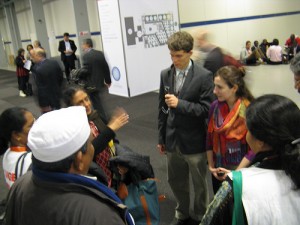Since returning from the United Nations Climate Change Conference in Copenhagen this December, many people have asked me “how was it?” And despite the frequency of this question, I find it very difficult to answer. What exactly are you asking? Are you asking if I enjoyed my experience? Whether or not the conference was a success? Or if I liked the Danish pastries? Certainly anyone who has studied abroad can attest to this difficulty…
But with this experience in particular I find it even more troublesome to negotiate. On the surface, my answer serves to both satisfy those who feel obligated to ask as well as describe what actually transpired during the two weeks of negotiations. But on another level, my response reflects how I view the problem of climate change, itself.
As for what actually occurred, no legally binding climate treaty was produced. Rather, the Copenhagen Accord put some fundamental steps in place for a more thorough climate pact to be produced in Mexico City next year. This may not come as a surprise since the media was calling the conference a failure even before it commenced. Prior to my arrival I was aware of some of the obstacles standing in the way. What I came to truly understand, however, is the actual scope and complexity of the problem as well as what it’s going to take in order to address it.
Climate change is not merely an environmental issue; nor is it a political or economic one. Climate change is an everything issue. Trying to coordinate a response that both prioritizes and balances areas of funding, capacity building, trade, mitigation, adaptation, as well as environmental, ecological and social justice is certainly a daunting task. Unfortunately, it takes time in order to develop these policies—especially at the international level. Realizing this while hearing some of the most vulnerable peoples of the changing climate beseech for urgent action was especially heartbreaking. I’ll never forget the looks of desperation from the Presidents of the Maldives and Kiribati, two island countries where its citizens will eventually become environmental refugees if significant (and I mean significant) emission reductions are not made. To this end—knowing the urgency of the issue and observing how slow progress is made—I’m rather disheartened by the outcome of the conference.
But I’ve also forced myself to draw some sort of encouragement from this experience. After all, it was amazing being surrounded with people from every country of the world and hearing groups of individuals speak out to have their voices heard. My representation at the conference extended beyond my official observer status as a part of Dickinson’s research delegation. I was also there are as a part of the international youth constituency, advocating for climate justice because it will be our generations problem to inherit.
So having been to this conference and observing its impact, have I retained a sense of hope? Surprisingly enough, I have. It’s just that my trust for the international political process to effectively solve this issue has weakened. Ultimately it’s going to take much more than policy alone if climate change is ever appropriately addressed. It will take changes in individual lifestyle choices, greater community involvement, business incentives, and local and domestic initiatives. Now more than ever, I’m inspired to keep fighting.
A frequent refrain of many who dispute evidence of human caused climate change is that the climate stopped warming in the late 1990s. Some even assert that the planet is now cooling and that this disproves the mainstream scientific view that, by increasing the concentrations of greenhouse gases in the atmosphere, humans are warming the Earth’s climate. Advocates of the proposition that humans are not warming the planet point to estimates of annual global mean surface temperature for the period from the late 1990s to the present, a period for which there is not a trend that is statistically significant.

Global temperature anomalies from 1992 through 2008 as estimated by the Hadley Centre. Temperatures are shown as the difference from the 1961-1990 average. Source: Scott, ClimateWatch Magazine.
What does this mean? There is a good article by Michon Scott in NOAA’s online ClimateWatch Magazine about the recent temperature data and the implications for climate change. A few key points to bear in mind are summarized here. But do access and read the full article – also search out what others have to say on this topic, take a look for yourself at the observational record, and become better informed.
As a starting point, it is important to recognize that annual variation in global average temperature is large relative to trends that might typically be observed over a period of 10 or so years – whether those trends are driven by natural or human causes. Research by Easterling and Wehner, as summarized by Scott, shows that a number of decades in the period 1901 to 2009 had no statistically significant warming or cooling trend. Yet these occur within a longer-term context in which temperatures at the end of the 20th century and beginning of the 21st century are significantly higher, in statistical terms, than in the early years of the 20th century.
The lack of a warming trend in some decades is not inconsistent with longer term warming. In fact, it is entirely expected, and even predicted by climate models, that there will be some decades of little or no warming set within a period of accumulating greenhouse gases in the atmosphere that drive warming over a multi-decadal time scale. Note also that, while there is no clear warming trend in recent years, the decade that just ended was exceptionally warm – the warmest decade on record according to NASA’s Goddard Institute for Space Studies.

This graph shows Global Average Temperature compared with the Atlantic Multi-decadal Oscillation (AMO) Index. The AMO Index is the average sea-surface temperature over the North Atlantic Ocean. The roughly parallel curves of the two parameters show that they are related: the increase in global temperature over time, coincident with the increase in greenhouse gases observed since the Industrial Revolution, is alternately obscured and enhanced by the AMO. Source: Scott, ClimateWatch Magazine.
So the recent temperature record by no means disproves human caused climate change. The longer-term record amply demonstrates that the climate has warmed and that the climate is significantly warmer now than in the past 100 years. The record also gives compelling evidence to expect that the climate will continue to warm in the future.
Neil Leary
The intensive, interdisciplinary, and hands-on mosaic programs that I have taken while at Dickinson College have been the best and most unique educational experiences of my college career.
The course From Kyoto to Copenhagen is more than just a course with a traveling component. The program offers the unique experience for students to get their hands dirty and try to make sense of what is going on at ground zero. Students need and should be given the opportunity at their college to take part in an engaging program where they go outside the classroom and learn by experience. I would argue that the difference between a regular course and an intensive mosaic semester is comparable to the difference between reading a dry science text book and performing the experiment yourself.

Bettina Cerban and Philip Rothrock interview representatives from an Indian NGO at the UN conference in Copenhagen
Going to the UN convention as part of a team and a class provided students with a purpose. Our team had a preselected research topic and video documentary goal, which helped to make our responsibilities more focused and manageable. At times the interviews felt constraining, but this commitment was outweighed by the risk of being overwhelmed by such a large number of interesting events to choose from. As part of the experimental process, we questioned and refined our methods and even our research focus. In the end we managed to collect a lot of interesting interviews and video footage. The range of different backgrounds and disciplines of each member of our research team helped to enrich our discussions and results. Intensive programs like these benefit from a diverse range of participants and an interdisciplinary approach.
At the same time, attending the UN conference was also an opportunity for students to pursue many personal academic interests. The variety of events and delegates allowed students to learn about a wider range of topics than could ever be possible within individual academic institutions. Furthermore this program was a once and a lifetime experience to be able to meet with and (in some cases) social network with global leaders. Intensive programs like this one helped me to develop much closer bonds with my classmates and my professors than would have been otherwise possible. Mosaic programs should balance group goals and individual development, so that students have the opportunity to take personal initiative and focus on individual learning, while contributing to the objectives of the research team.
Having also previously taken another intensive mosaic semester (the LUCE semester), I would argue that every institution of higher education should seriously consider offering multiple intensive, interdisiplinary, and hands-on mosaic programs. This is because these programs provide students with opportunities to apply their knowledge outside the classroom and engage with a variety of experts. These two mosaic experiences have deepened my understanding of environmental issues, while at the same time they have intesified my intellectual curiosity and commitment. These semesters have been more challenging and much more rewarding than other courses I have taken.
Tags: Dickinson College, Kyoto to Copenhagen, mosaic programs, Philip Rothrock, student-citizens
The results of this conference should not be taken in isolation, but should be seen as part of a continuum of international negotiations on global climate change. The COP15 convention in Copenhagen was pegged by the UNFCCC in Kyoto to be a focal point and deadline for binding emissions agreements. However, political negotiations are exceedingly slow and unpredictable. It can be difficult to determine when and what actions will be the tipping point for significant improvements in climate change policies on a global scale. Whether we like it or not political negotiations in Copenhagen did not meet the intended goals of the convention.
This is incredibly disconcerting considering all of the heart wrenching stories that were made by representatives from low lying island nations and African nations vulnerable to the effects of Climate Change.
Unfortunately, no matter how morally compelling it is for countries to have binding emissions standards it is extremely difficult politically to reach an international agreement where all countries commit to binding emissions. This is not excuse for the meager results of the conference, but it is an explanation.
The world has limited time to act, but thankfully these negotiations do not all rest on one conference. The current negotiations are a culmination of past conferences and meetings of the parties. Despite numerous unresolved problems, there is still an opportunity to achieve substantial results next December in the COP16 in Mexico City. The most important concept to understand is that change needs to be done at all different scales.
States have the opportunity to develop holistic management that incorporates climate change into political dialogue and international agreements outside of the convention. For example, multilateral negotiations within other contexts like the G8 summits have the potential to produce improvements.
Also, domestic law is also an area where large improvements need to be made. In the US, the climate change legislation has been incredibly important in influencing the debate within the Copenhagen convention. It is critical that strong climate change legislation passes in June so that the US can negotiate with firm domestic laws already in place.
Finally and most importantly, every person must make improvements within their own lives, because this is a global problem that effects all different scales of human interaction. Transitioning to lower carbon lifestyles and demanding political action by our leaders are essential steps to keep the momentum going for a successful Convention in Mexico next year.
Tags: climate change, COP15 results, Kyoto Protocol, Philip Rothrock, student-citizens
At Hillary Clinton’s press conference in Copenhagen today, she called for international cooperation from all parts of the world and commitments from all major emitters. Clinton announced the US’s commitment to spend 100b/yr by 2020 for climate adaptation in poor countries. However, she made it clear that the US’s financial commitment is contingent on a transparent commitment from China. Click on the link to see Hillary’s full address–>
http://www.youtube.com/watch?v=l8u42SVaaUs
Tags: climate change, COP15 Resources, Copenhagen, Grace Lange, Hillary Clinton, Public Policy




Your Comments